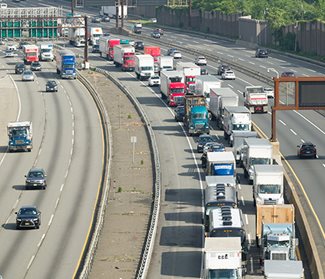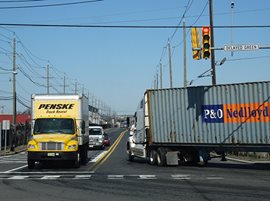 As the economy recovers, the trucking industry faces surging demand for moving goods but remains hampered by a severe driver shortage despite offering higher wages, along with a continuing need for additional truck parking. The NJTPA Freight Initiatives Committee learned about these dilemmas and other issues facing the industry from experts at the June 14 committee meeting.
As the economy recovers, the trucking industry faces surging demand for moving goods but remains hampered by a severe driver shortage despite offering higher wages, along with a continuing need for additional truck parking. The NJTPA Freight Initiatives Committee learned about these dilemmas and other issues facing the industry from experts at the June 14 committee meeting.
Committee Chair Charles Kenny, a Middlesex County Commissioner, welcomed participants and introduced the speakers who provided the NJTPA with its annual trucking Industry update.
Bob Costello, Chief Economist for the American Trucking Associations, said the surge in demand for goods movement covers all aspects of freight. This includes consumer goods being boosted by a tremendous growth in e-commerce; demand for construction materials driven by home building activity at a level greater than before the Great Recession; and expanding manufacturing despite headwinds from the pandemic and international competition.
But the lack of drivers is hampering the industry’s response. “Demand is up; pricing is strong,” Costello said. “Supply [of labor] should be coming around and increasing but it’s doing the opposite – it’s decreasing.”
Among the causes of the driver shortage are structural factors: an older workforce compared to other industries; restrictions on people under 21 becoming drivers; very few women drivers (only 7 percent compared to 42 percent for other jobs); and drug and alcohol screening banning drivers even for marijuana use. Overall, he said the industry is facing a shortage of over 100,000 drivers nationally.
Increased pay for drivers is not necessarily the answer, he said. Often, given the grueling nature of the work – especially for long haul drivers – other factors can matter more, including avoiding spending long stretches away from home. In considering jobs, he said, “A lot of people are saying, you know what, I'll take less money and be home every day.” Many drivers are switching to companies serving local markets or taking advantage of increased pay to work fewer hours.
 The next speaker, Daniel Murray, Senior Vice President of the American Transportation Research Institute, said despite the challenges, 2021-2022 should be “a banner year” for the industry. He said a recent report by his organization found that truck parking was drivers’ top concern, beating out wages/compensation for the first time. He said the daily difficulties of finding parking contributed to drivers leaving the industry – “the last nail in the coffin, sort of thing” he said.
The next speaker, Daniel Murray, Senior Vice President of the American Transportation Research Institute, said despite the challenges, 2021-2022 should be “a banner year” for the industry. He said a recent report by his organization found that truck parking was drivers’ top concern, beating out wages/compensation for the first time. He said the daily difficulties of finding parking contributed to drivers leaving the industry – “the last nail in the coffin, sort of thing” he said.
If the lack of parking is not addressed – for instance through dedicated funding in the next federal infrastructure bill – he said the issue “could have repercussions far into the future” for the nation’s ability to meet freight demands. Providing secure and safe parking is particularly important for attracting more women drivers, he said.
Also of great concern is a growing shortage of diesel mechanics to service more sophisticated – and eventually automated – trucks and rising costs for insurance which often places the largest burdens on small operators, Murray said.
Thomas Weakley, Director of Operations at the Owner-Operator Independent Drivers Association, said the owner-operators in his organization faced an “extremely difficult” 2020 due to the loss of business and the tight profit margins on which they operate. But with the recovery, most are now benefiting from growing demand to haul freight and increasing prices. He said in contrast to staff shortages facing large trucking companies, there is a growing demand by truckers to become owner-operators. Applications for authorization to become independent are up 60 percent from last year, reflecting in part the greater flexibility and ability to choose shorter trips afforded by independence.
He underscored the importance of expanding truck parking, noting that drivers can face “ripple effects” from the failure to find parking – committing violations of service hours, continuing to drive when fatigued, longer idling and being forced to park illegally and unsafely. Other pressing issues facing owner-operators include the growing burden of tolls and congestion pricing; delays at ports due to backups in processing ship cargoes; growing pressures to meet tight delivery timeframes as a result of consumer demands; and unfair insurance rates with threats of further increases and new regulations.
Following their remarks, the three speakers were asked what they view as the greatest threats to the industry. Among the issues mentioned were the continuing driver shortage which is causing turnover and increasing competition among carriers; the threat of drug testing to sideline drivers for minor offenses involving marijuana use, which many states have legalized; and lack of federal progress and agreement in Congress on investing in needed infrastructure to improve roads and support drivers. A recording of the meeting and the presentation slides are available at njtpa.org/June2021FIC.